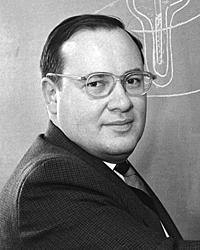Arthur Leonard Schawlow
| Arthur Leonard Schawlow | |
|---|---|
 Arthur Leonard Schawlow
|
|
| Born | May 5, 1921 Mount Vernon, New York |
| Died | April 28, 1999 (aged 77) Palo Alto, California |
| Nationality | United States |
| Fields | Physics |
| Institutions | Bell Labs Columbia University Stanford University |
| Alma mater | University of Toronto |
| Doctoral advisor | Malcolm Crawford |
| Known for | laser spectroscopy |
| Notable awards | Nobel Prize for Physics (1981) |
Arthur Leonard Schawlow (May 5, 1921 – April 28, 1999) was an American physicist. He is best remembered for his work on lasers, for which he shared the 1981 Nobel Prize in Physics with Nicolaas Bloembergen and Kai Siegbahn.
Contents |
Biography
His mother, Helen Mason, was from Canada and his father, Arthur Schawlow, was a Jewish immigrant from Latvia. When Arthur was three years old, they moved to Toronto, Canada.
At the age of 16 he completed high school and received a scholarship in science at the University of Toronto. After earning his undergraduate degree Schawlow continued in graduate school at the University of Toronto which was interrupted due to World War II. At the end of the war he began work on his Ph.D at U of T with Professor Malcolm Crawford. He then took a postdoctoral position with Charles Townes at the physics department of Columbia University in the fall of 1949.
In 1951 he married Aurelia Townes, younger sister to Charles Townes, and together they had three children; Arthur Jr., Helen, and Edith. Arthur Jr. was autistic, with very little speech ability.
He considered himself to be an orthodox Protestant Christian and attended a Methodist church.[1]
He went on to accept a position at Bell Labs in late 1951. He left in 1961 to join the faculty at Stanford University as a professor. He remained until he retired to emeritus status in 1996.
Schawlow and Professor Robert Hofstadter at Stanford, who also had an autistic child, teamed up to help each other find solutions to the condition. Arthur Jr. was put in a special center for autistic individuals, and later Schawlow put together an institution to care for people with autism in Paradise, California. It was later named the Arthur Schawlow Center in 1999, shortly before his death.
Schawlow was a promoter of the controversial method of facilitated communication with patients of autism.[2]
Although his research focused on optics, in particular, lasers and their use in spectroscopy, he also pursued investigations in the areas of superconductivity and nuclear resonance. Schawlow shared the 1981 Nobel Prize in Physics with Nicolaas Bloembergen and Kai Siegbahn for their contributions to the development of laser spectroscopy.
Schawlow coauthored Microwave Spectroscopy (1955) with Charles Townes. Also with Townes, they prepared a much disputed, by Gordon Gould, laser patent filed by Bell Labs in 1958.
In 1991 the NEC Corporation and the American Physical Society established a prize: the Arthur L. Schawlow Prize in Laser Science. The prize is awarded annually to "candidates who have made outstanding contributions to basic research using lasers."
Schawlow was born in Mount Vernon, New York and died of leukemia in Palo Alto, California.He is survived by Cleo and Thomasina Johnson and Andy, Rachel, and Colin Dwan.
Awards
- 1962 - Stuart Ballantine Medal
- 1963 - Young Medal and Prize, for distinguished research in the field of optics presented by the Institute of physics
- 1976 - awarded the Frederic Ives Medal by OSA
- 1981 - Nobel Prize for Physics
Science and Religion
He has participated in science and religion discussions. Regarding God, he stated "I find a need for God in the universe and in my own life."[3]
Bibliography
- Schawlow, A L (1995), "Principles of lasers.", Journal of clinical laser medicine & surgery 13 (3): 127–30, 1995 Jun, PMID 10150635
- Schawlow, AL (1982), "Spectroscopy in a New Light.", Science 217 (4554): 9–16, 1982 Jul 2, doi:10.1126/science.217.4554.9, PMID 17739964
- Schawlow, AL (1978), "Laser Spectroscopy of Atoms and Molecules.", Science 202 (4364): 141–147, 1978 Oct 13, doi:10.1126/science.202.4364.141, PMID 17801904
- McCaul, B W; Schawlow, A L (1969), "Plasma refractive effects in HCN lasers.", Ann. N. Y. Acad. Sci. 168 (3): 697–702, 1969 Feb 10, doi:10.1111/j.1749-6632.1969.tb43154.x, PMID 5273948
- Schawlow, A L (1966), "Lasers.", International ophthalmology clinics 6 (2): 241–51, doi:10.1097/00004397-196600620-00002, PMID 5958291
References
- ↑ http://www.adherents.com/people/ps/Arthur_Schawlow.html
- ↑ http://news-service.stanford.edu/news/1999/may5/schawlowobit-55.html][http://suedweb.syr.edu/thefci/2-1sch.htm
- ↑ Margenau, H. (1992), Cosmos, Bios, Theos: Scientists Reflect on Science, God, and the Origins of the Universe, Life, and Homo sapiens, Open Court Publishing Company, p. 105 co-edited with Roy Abraham Varghese. This book is mentioned in a December 28, 1992 Time magazine article: Galileo And Other Faithful Scientists
External links
- National Academy of Sciences biography
- Nobel Winner: Arthur Leonard Schawlow
- Bright Idea: The First Lasers (laser history)
- Press Release: The 1981 Nobel Prize in Physics
- Arthur Leonard Schawlow obituary
See also
- Optical Society of America#Past Presidents of the OSA
|
||||||||||||||||||||